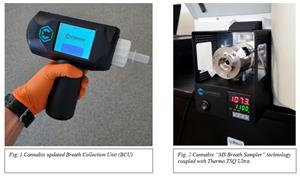Currently, in
We are excited about the opportunity to work with
Current forms of testing for marijuana use can identify THC ranging from minutes to days after actual use, making it impossible to show the difference between the two. Studies¹ have shown that breath is a better indicator of impairment than saliva, blood, or urine because THC is present in breath for a relatively short period of time (1-3 hours) after consumption; whereas, it is excreted at detectable levels in other body fluids for many hours, days, or even weeks after smoking. This short time period of detection in breath aligns with the peak impairment window.
The Company’s handheld Breath Collection Unit (“BCU”, Fig. 1) and newly developed laboratory “MS Breath Sampler” (Fig. 2) are being used together to provide a new method for drug detection that complements gold-standard mass spectrometry (MS) and significantly simplifies laboratory analysis methods, reduces sample turnaround times (thus minimizing operating costs), while maintaining sensitive, precise results. It should be noted the BCU is also being used in concert with the Cannabix FAIMS Detection Unit (a separate device, under development, not part of this pilot, which is being developed as a portable system capable of both breath collection and analyses in the field).
The Cannabix BCU will provide quick and nonintrusive breath sample collection and easy analysis with no sample preparation needed in a lab setting using the Company’s “MS Breath Sampler” hardware. In comparison, existing and legacy breath and saliva testing procedures require several sample extraction and preparation steps prior to analysis, and analysis itself can take from 1 – 3 hours per sample. This is expensive and impractical. Also, existing and legacy breath and saliva testing procedures tend to have inefficient, time-consuming collection methods, and recoveries are still often poor.
Readers should note, although the Company has achieved proof of concept prototype for its BCU and MS Breath Sampler, the testing method and device is still in the preapproval stage and accordingly the Company is not currently making any express or implied claims that the technology will proceed to commercial use.
(1) Olla P, Ishraque MT, Bartol S. 2020. Evaluation of Breath and Plasma Tetrahydrocannabinol Concentration Trends Postcannabis Exposure in Medical Cannabis Patients. Cannabis and Cannabinoid Res.; 99-104.
Himes S. et al. 2013. Cannabinoids in Exhaled Breath following
Beck O, Sandqvist S, Dubbelboer I, Franck J. 2011. Detection of delta9-tetrahydrocannabinol in exhaled breath collected from cannabis users. J Anal Toxicol; 35:541– 4.
About
We seek Safe Harbor.
On behalf of the Board of Directors
“Rav Mlait”
CEO
For further information, contact the Company at info@cannabixtechnologies.com
The CSE has not reviewed and does not accept responsibility for the adequacy or accuracy of this release.
Cautionary Statement Regarding Forward-Looking Statements
This press release contains forward-looking information that involves various risks and uncertainties regarding future events. Such forward-looking information can include without limitation statements based on current expectations involving a number of risks and uncertainties and are not guarantees of future performance of the Company, such as final development of a commercial or prototype product(s), successful trial or pilot of company technologies, no assurance that commercial sales of any kind actually materialize; no assurance the Company will have sufficient funds to complete product development. There are numerous risks and uncertainties that could cause actual results and the Company’s plans and objectives to differ materially from those expressed in the forward-looking information, including: (i) adverse market conditions; (ii) risks regarding protection of proprietary technology; (iii) the ability of the Company to complete financings; (iv) the ability of the Company to develop and market its future product; and (v) risks regarding government regulation, managing and maintaining growth, the effect of adverse publicity, litigation, competition and other factors which may be identified from time to time in the Company’s public announcements and filings. There is no assurance that its development of marijuana breathalyzer technology will provide any benefit to the Company, and no assurance that any proposed new products will be built, will be successful in beta testing or clinical trials. There is no assurance that existing “patent pending” technologies licensed by the Company will receive patent status by regulatory authorities. The Company is not currently selling commercial breathalyzers. Actual results and future events could differ materially from those anticipated in such information. These and all subsequent written and oral forward-looking information are based on estimates and opinions of management on the dates they are made and are expressly qualified in their entirety by this notice. Except as required by law, the Company does not intend to update these forward-looking statements.
A photo accompanying this announcement is available at https://www.globenewswire.com/NewsRoom/AttachmentNg/d649e2e5-8634-4643-b56c-8a87bddb1cf7

Cannabix November 7 2022 Figure 1 and 2

Cannabix updated Breath Collection Unit (BCU) Cannabix “MS Breath Sampler” technology
Source:
2022 GlobeNewswire, Inc., source


Be the first to comment